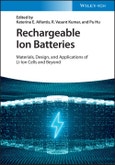Rechargeable Ion Batteries
Highly informative and comprehensive resource providing knowledge on underlying concepts, materials, ongoing developments and the many applications of ion-based batteries
Rechargeable Ion Batteries explores the concepts and the design of rechargeable ion batteries, including their materials chemistries, applications, stability, and novel developments. Focus is given on state-of-the-art Li-based batteries used for portable electronics and electric vehicles, while other emerging ion-battery technologies are also introduced. The text addresses innovative approaches by reviewing nanostructured anodes and cathodes that pave new ways for enhancing the electrochemical performance.
The first three chapters are dedicated to the general concepts of electrochemical cells, enabling readers to understand all necessary concepts for batteries from a single book. The following chapter covers the exciting applications of lithium-ion and sodium-ion batteries, while the subsequent chapters on Li-battery components include new types of anodes, cathodes, and electrolytes that have been developed recently, complemented by an overview of designing mechanically stable ion-battery systems. The last three chapters summarize recent progress in lithium-sulfur, sodium-ion, magnesium-ion and zinc and emerging ion-battery technologies.
In Rechargeable Ion Batteries, readers can expect to find specific information on: - Electrochemical cells, primary batteries, secondary batteries, recycling of batteries, applications of lithium and sodium batteries - Next-generation cathodes, anodes and electrolytes for secondary lithium-ion batteries, which allow for improved performance and safety - Multiphysics modeling for predicting design criteria for next generation ion-insertion electrodes - Developments in lithium-sulfur batteries, sodium-ion batteries, and future ion-battery technologies
Rechargeable Ion Batteries provides informative and comprehensive coverage of the subject to interested researchers, academics, and professionals in various fields, including materials science, electrochemistry, physical chemistry, mechanics, engineering, recycling and industry including the battery manufacturers and supply chain ancillaries, automotive, aerospace, and marine sectors, energy storage installers and environmental stakeholders. Readers can easily acquire a base of knowledge on the subject while understanding future developments in the field.
Highly informative and comprehensive resource providing knowledge on underlying concepts, materials, ongoing developments and the many applications of ion-based batteries
Rechargeable Ion Batteries explores the concepts and the design of rechargeable ion batteries, including their materials chemistries, applications, stability, and novel developments. Focus is given on state-of-the-art Li-based batteries used for portable electronics and electric vehicles, while other emerging ion-battery technologies are also introduced. The text addresses innovative approaches by reviewing nanostructured anodes and cathodes that pave new ways for enhancing the electrochemical performance.
The first three chapters are dedicated to the general concepts of electrochemical cells, enabling readers to understand all necessary concepts for batteries from a single book. The following chapter covers the exciting applications of lithium-ion and sodium-ion batteries, while the subsequent chapters on Li-battery components include new types of anodes, cathodes, and electrolytes that have been developed recently, complemented by an overview of designing mechanically stable ion-battery systems. The last three chapters summarize recent progress in lithium-sulfur, sodium-ion, magnesium-ion and zinc and emerging ion-battery technologies.
In Rechargeable Ion Batteries, readers can expect to find specific information on: - Electrochemical cells, primary batteries, secondary batteries, recycling of batteries, applications of lithium and sodium batteries - Next-generation cathodes, anodes and electrolytes for secondary lithium-ion batteries, which allow for improved performance and safety - Multiphysics modeling for predicting design criteria for next generation ion-insertion electrodes - Developments in lithium-sulfur batteries, sodium-ion batteries, and future ion-battery technologies
Rechargeable Ion Batteries provides informative and comprehensive coverage of the subject to interested researchers, academics, and professionals in various fields, including materials science, electrochemistry, physical chemistry, mechanics, engineering, recycling and industry including the battery manufacturers and supply chain ancillaries, automotive, aerospace, and marine sectors, energy storage installers and environmental stakeholders. Readers can easily acquire a base of knowledge on the subject while understanding future developments in the field.
Table of Contents
1 INTRODUCTION TO ELECTROCHEMICAL CELLS1.1 What are Batteries?
1.2 Quantities Characterizing Batteries
1.3 Primary and Secondary Batteries
1.4 Battery Market
1.5 Recycling and Safety Issues
2 MATERIALS FOR AND CHEMISTRY OF PRIMARY BATTERIES
2.1 Introduction
2.2 The Early Batteries
2.3 The Zinc/Carbon Cell
2.4 Alkaline Batteries
2.4.1 Electrochemical Reactions
2.5 Button Batteries
2.6 Li Primary Batteries
2.7 Oxyride Batteries
2.8 Damage in Primary Batteries
2.9 Conclusions
3 MATERIALS FOR AND CHEMISTRY OF SECONDARY BATTERIES
3.1 The Lead-Acid Battery
3.2 The Nickel-Cadmium Battery
3.3 Nickel-Metal Hydride (Ni-MH) Batteries
3.4 Secondary Alkaline Batteries
3.5 Secondary Lithium Batteries
3.6 Lithium-Sulfur Batteries
3.7 Conclusions
4 APPLICATIONS OF SECONDARY LI BATTERIES
4.1 Portable Electronic Devices
4.2 Hybrid and Electric Vehicles
4.3 Medical Applications
4.4 Application of Secondary Li Ion Battery Systems in Vehicle Technology
5 NEXT GENERATION CATHODES FOR SECONDARY LI-ION BATTTERIES
5.1 Energy Density and Thermodynamics
5.2 Materials Chemistry and Engineering of Voltage Plateau
5.3 Multitransition Metal Oxide Engineering for Capacity and Stability
5.4 Conclusion
6 NEXT-GENERATION ANODES FOR SECONDARY LI-ION BATTERIES
6.1 Introduction
6.2 Chemical Attack by the Electrolyte
6.3 Mechanical Instabilities during Electrochemical Cycling
6.4 Nanostructured Anodes
6.5 Thin Film Anodes
6.6 Nanofiber/Nanotube/Nanowire Anodes
6.7 Active/Less Active Nanostructured Anodes
6.8 Other Anode Materials
6.9 Conclusions
7 NEXT-GENERATION ELECTROLYTES FOR LI BATTERIES
7.1 Introduction
7.2 Background
7.3 Preparation and Characterization of Polymer Electrolytes
7.3.1 Preparation of Polymer Electrolytes
7.3.2 Characterization of Molten-Salt-Containing Polymer Gel Electrolytes
7.3.3 Characterization of Organic-Modified MMT-Containing Polymer Composite Electrolytes
7.3.4 Ion-Exchanged Li-MMT-Containing Polymer Composite Electrolytes
7.3.5 Mesoporous Silicate (MCM-41)-Containing Polymer Composite Electrolytes
7.4 Conclusions
8 DESIGNING MECHANICALLY STABLE ION-BATTERY SYSTEMS
8.1 Introduction
8.2 Mechanics Considerations During Battery Life
8.3 Modeling Elasticity and Fracture During Electrochemical Cycling
8.4 Multiscale Phenomena and Considerations in Modeling
8.5 Particle Models of Coupled Diffusion and Stress Generation
8.6 Diffusional Processes During Cycling
8.7 Conclusions
9 DEVELOPMENTS IN LI-S BATTERIES
9.1 Introduction to Li-S Batteries
9.2 Electrochemical Principles
9.3 Sulfur Utilisation and Cycle Life
9.4 Potential Solutions to Outstanding Problems
9.5 Carbon Materials
9.6 Metal Oxide-Sulfur Composites
9.7 Polymers
9.8 Some New Developments
9.9 Conclusions
10 NA-ION BATTERIES
10.1 Introduction
10.2 Cathode Materials for Na-ion Batteries
10.3 Anode Materials for Na-ion Batteries
10.4 Electrolyte for Na-ion Batteries
10.5 Conclusions
11 NOVEL ION-BATTERY TECHNOLOGIES
11.1 Introduction
11.2 Mn-ion Batteries
11.3 K-ion Batteries
11.4 Other-ion Batteries
11.5 Conclusions








